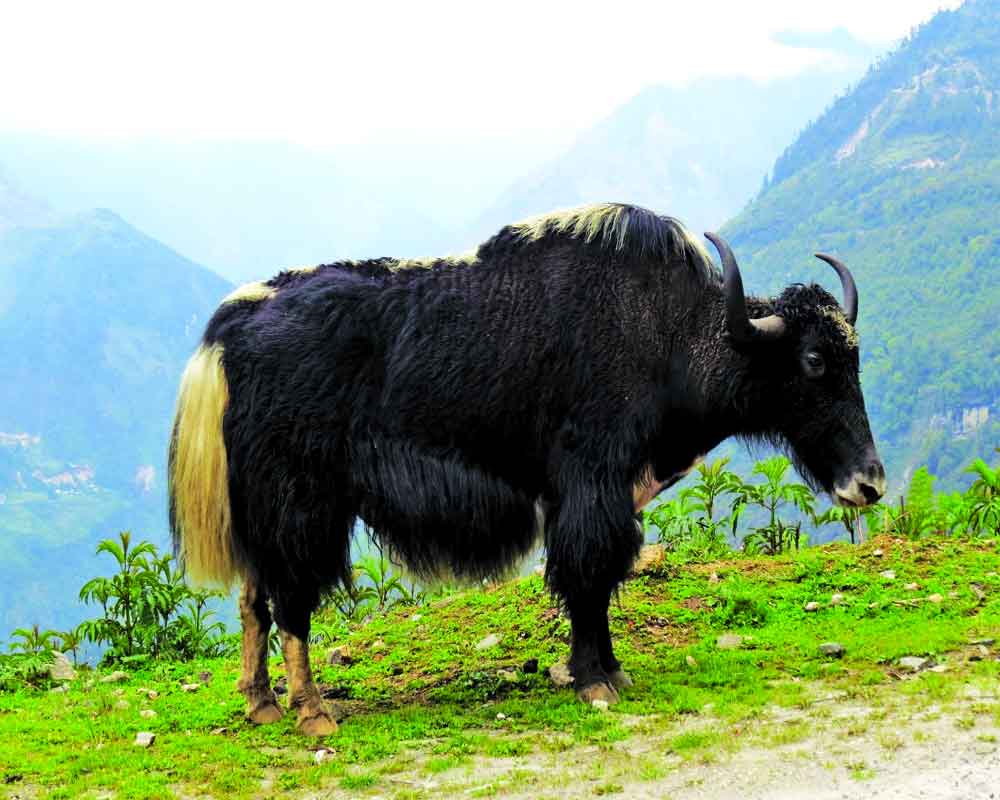For the people of Arunachal Pradesh, Yak is indispensable. Human life here depends on it but its population is dwindling, which needs to be corrected
Arunachal Pradesh is the largest among North Eastern states of India having an area of 83,743 km and is divided into 20 administrative districts of which highlanders (3000-4000 meters above MSL) are Tawang and West Kameng districts. It borders the states of Assam and Nagaland to the South and shares Internationals borders with Bhutan in the East and Tibet (China) in the North. The state is the home tract of Arunachali Yak. Usually found at elevations 3,000-6,000 meters above MSL, Arunachali Yak sustains themselves up to a temperature of -40 to 10 degrees centigrade. Arunachali Yak is one of the purest Yak populations in the world. It is considered a remarkable domestic animal as it thrives in conditions of extreme cold and hypoxic conditions of hardness and deprivation while providing livelihood to people living in the remote high altitude hilly terrain of Tawang and West Kameng districts of Arunachal Pradesh. These two districts are rich in agro-biodiversity having the origin of several plants. The socio-diversity of these districts adds more colour to this field of bio-diversity. The average density is about 11-13 people per km, but, the concentration of population is more at lower elevations and plains rather than at high altitude regions where Yaks are available.
Although no written literature and breed synonyms exist about Yak, the oral history indicates that this animal belongs to the Bisontine group under the subfamily Bovidae which was first tamed by the ancient Qiang people of the Tibetan-Qiang plateau in China. Given its grass-eating nature and having specific anatomical and morphological differences from other Bovids, the nomenclature (Poephagus) was given after a thorough investigation and discussion. According to the evolutionary consequences, it is presumed that the domestic Yak (Poephagus grannies L.) of Arunachal Pradesh probably originated from its wild counterpart (Poephagus mutus). The Arunachali Yak is living in a transhumance pastoral structure and exists in semi-migratory systems. Few animals are also found in the organized farm.
Monpa community, which is the majority population in West Kameng and Tawang districts, is responsible for developing the Arunachali Yak breed. Yak has been closely associated with the culture, religion, and social life of the Monpa people who can trace their history of Yak with great care since time immemorial. It is treated as an asset of the rural economy. The Yak rearers, also called the Brokpa, make their herds migrate during the summer season, along the mountain ridges for grazing. One full-time attendant stay at the pasture land all along, attending the herds, milking and preparing butter, ghee, and churpi (fermented butter) for home consumption as well as for commercial purposes. The entire herd is brought back to the nearby homestead during the winter season when there is heavy snowfall. Agriculture is the mainstay of the Yak farmers and about 80 percent population depends on it. Shifting (Jhum} cultivation is practiced by Monpa Community settled in the Yak rearing region. Due to the availability of varied agro-climatic and topographic conditions, diverse varieties of crops are found. Other crops like chili, soybean, potato, cabbage, pumpkin and ginger are also grown. Major fruit production is kiwi, apple and orange as well as some citrus fruits. The houses of Yak rearers, the Monpas, are the traditional style of dwellings made from locally available materials. The house size and area depends on the family patterns. The average family members household consist of six
members and 50 percent of them are literate and 50 percent are involved in Yak husbandry. In Arunachal Pradesh, landholding is community-based: the average agriculture landholding is 4500 acres and the annual income of Yak farmers is `55,000.
It is a matter of concern that over the years, the population of Arunachali Yak has been declining. The main reasons are increased emphasis on crossbreeding, a shift in profession from agriculture to other sectors, threats from predators and diseases, reduction in the availability of fodder, and a reduced enthusiasm among young herders although it is still believed that rearing Yak is the social status of Brokpa. This decline can be curbed through the introduction of selection and mating programmes that could encourage both productivity and the maintenance of biodiversity as well as distribution of unique germplasm through AI-semen, high altitude pasture management, adopting new technology in villages near border areas where Yak is only animal providing livelihood and economic sustainability. Regular training on the latest technology for Yak husbandry for a veterinarian, veterinary field assistants, as well as Yak farmers, boosts the Yak husbandry in the region.
Another area of concern is that there is no proper documentation of the Yak population because no serious efforts have been done to survey population of Yak. In this context, systematic documentation is needed for the interpretation of earlier sources and where possible be cross-checked against pastoralists’ accounts. Efforts for the conservation of the Arunachali Yak as well as to increase their productivity within the given environment need urgent attention. Heterotic effects are evident in the crosses, but these need to be further classified and exploited for the conservation and multiplication of Arunacahali Yak.
(The writer is a senior journalist. The views expressed are personal. This is the second part of the three-part series on the northeast; to be concluded.)


























